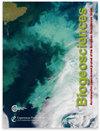Scaling carbon fluxes from eddy covariance sites to globe: synthesis and evaluation of the FLUXCOM approach
IF 3.9
2区 地球科学
Q1 ECOLOGY
引用次数: 315
Abstract
Abstract. FLUXNET comprises globally distributed eddy-covariance-based estimates of carbon fluxes between the biosphere and the atmosphere. Since eddy covariance flux towers have a relatively small footprint and are distributed unevenly across the world, upscaling the observations is necessary to obtain global-scale estimates of biosphere–atmosphere exchange. Based on cross-consistency checks with atmospheric inversions, sun-induced fluorescence (SIF) and dynamic global vegetation models (DGVMs), here we provide a systematic assessment of the latest upscaling efforts for gross primary production (GPP) and net ecosystem exchange (NEE) of the FLUXCOM initiative, where different machine learning methods, forcing data sets and sets of predictor variables were employed. Spatial patterns of mean GPP are consistent across FLUXCOM and DGVM ensembles (R2>0.94 at 1∘ spatial resolution) while the majority of DGVMs show, for 70 % of the land surface, values outside the FLUXCOM range. Global mean GPP magnitudes for 2008–2010 from FLUXCOM members vary within 106 and 130 PgC yr−1 with the largest uncertainty in the tropics. Seasonal variations in independent SIF estimates agree better with FLUXCOM GPP (mean global pixel-wise R2∼0.75) than with GPP from DGVMs (mean global pixel-wise R2∼0.6). Seasonal variations in FLUXCOM NEE show good consistency with atmospheric inversion-based net land carbon fluxes, particularly for temperate and boreal regions (R2>0.92). Interannual variability of global NEE in FLUXCOM is underestimated compared to inversions and DGVMs. The FLUXCOM version which also uses meteorological inputs shows a strong co-variation in interannual patterns with inversions (R2=0.87 for 2001–2010). Mean regional NEE from FLUXCOM shows larger uptake than inversion and DGVM-based estimates, particularly in the tropics with discrepancies of up to several hundred grammes of carbon per square metre per year. These discrepancies can only partly be reconciled by carbon loss pathways that are implicit in inversions but not captured by the flux tower measurements such as carbon emissions from fires and water bodies. We hypothesize that a combination of systematic biases in the underlying eddy covariance data, in particular in tall tropical forests, and a lack of site history effects on NEE in FLUXCOM are likely responsible for the too strong tropical carbon sink estimated by FLUXCOM. Furthermore, as FLUXCOM does not account for CO2 fertilization effects, carbon flux trends are not realistic. Overall, current FLUXCOM estimates of mean annual and seasonal cycles of GPP as well as seasonal NEE variations provide useful constraints of global carbon cycling, while interannual variability patterns from FLUXCOM are valuable but require cautious interpretation. Exploring the diversity of Earth observation data and of machine learning concepts along with improved quality and quantity of flux tower measurements will facilitate further improvements of the FLUXCOM approach overall.从涡度协方差点到全球的碳通量标度:FLUXCOM方法的综合和评估
摘要FLUXNET包括基于全球分布涡协方差的生物圈和大气圈之间碳通量估计。由于涡流协方差通量塔的足迹相对较小,并且在世界各地分布不均,因此有必要扩大观测范围,以获得全球范围内的生物圈-大气交换估计值。基于与大气反演、太阳诱导荧光(SIF)和全球动态植被模型(DGVM)的交叉一致性检查,我们对FLXCOM倡议的最新初级生产总值(GPP)和网络生态系统交换(NEE)的升级工作进行了系统评估,其中不同的机器学习方法,采用强制数据集和预测变量集。平均GPP的空间模式在FLUXCOM和DGVM系综中是一致的(在1∘空间分辨率下R2>0.94),而大多数DGVM显示,对于70 % FLUXCOM范围之外的值。FLUXCOM成员2008-2010年全球平均GPP震级在106和130之间变化 PgC 在热带地区具有极大的确定性。独立SIF估计的季节变化与FLXCOM GPP(平均全局像素R2~0.75)相比,与DGVM的GPP(均值全局像素宽度R2~0.6)更好。FLXCOM NEE的季节变化显示出与基于大气反演的净陆地碳通量的良好一致性,特别是温带和北方地区(R2>0.92)。与反演和DGVM相比,FLUXCOM中全球NEE的年际变化被低估了。FLUXCOM版本也使用了气象学家,显示出与反演的年际模式存在强烈的协同变化(2001–2010年R2=0.87)。FLUXCOM的平均区域NEE显示出比反演和基于DGVM的估计更大的干扰,特别是在每年每平方米碳含量差异高达数百克的热带地区。这些差异只能部分通过碳损失途径来调和,碳损失途径隐含在反演中,但通量塔测量无法捕捉到,例如火灾和水体的碳排放。我们假设,潜在涡度协方差数据中的系统偏差,特别是在高大的热带森林中,以及FLXCOM中缺乏对NEE的站点历史影响,可能是FLXCOM估计的热带碳汇过强的原因。此外,由于FLUXCOM没有考虑二氧化碳施肥效应,碳通量趋势是不现实的。总体而言,目前FLUXCOM对GPPas的年均和季节性周期以及季节性NEE变化的估计为全球碳循环提供了有用的约束,而FLUXCOM的年际变化模式很有价值,但需要谨慎解释。探索地球观测数据和机器学习概念的多样性,以及提高通量塔测量的质量和数量,将有助于进一步改进FLUXCOM方法。
本文章由计算机程序翻译,如有差异,请以英文原文为准。
求助全文
约1分钟内获得全文
求助全文
来源期刊

Biogeosciences
环境科学-地球科学综合
CiteScore
8.60
自引率
8.20%
发文量
258
审稿时长
4.2 months
期刊介绍:
Biogeosciences (BG) is an international scientific journal dedicated to the publication and discussion of research articles, short communications and review papers on all aspects of the interactions between the biological, chemical and physical processes in terrestrial or extraterrestrial life with the geosphere, hydrosphere and atmosphere. The objective of the journal is to cut across the boundaries of established sciences and achieve an interdisciplinary view of these interactions. Experimental, conceptual and modelling approaches are welcome.
 求助内容:
求助内容: 应助结果提醒方式:
应助结果提醒方式:


